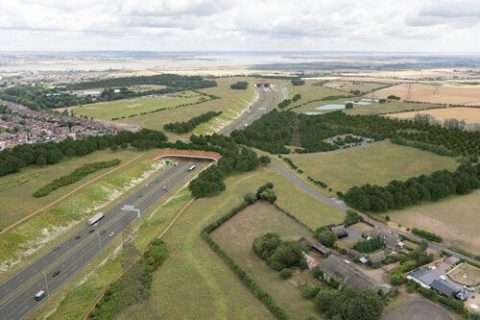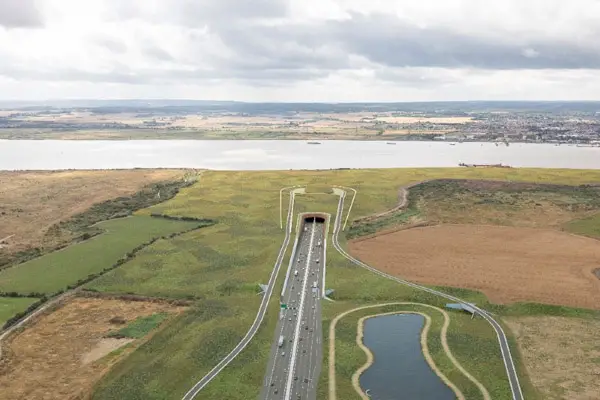The latest Sep 2023
A £2.3bn contract to dig the Lower Thames Crossings 4.2-kilometre tunnel will reportedly be awarded in a few weeks following over 12 months of competitive dialogue. The dialogue has been between the National Highways a trio of shortlisted bidders. the bidders include Bouygues/Murphy JV, Dragados-Hochtief (DH JV) and BAM Nuttall, Ferrovial Construction (UK) and Vinci Construction Grands Projets (BFV JV).
This contract will be the third to be awarded for the project this year. In January, Balfour Beatty won the first contract, a £1.2bn contract to construct 16 kilometres of highways connecting the M25 at Junction 29 and the A13 with the northern side of the proposed tunnel. In July 2023, the second contract was awarded to Skanska. Reportedly the £450 million contract covers the development of the southern part of the route connecting the A2/M2 to the tunnel approach. This development particularly involves the construction of new roads and structures, green bridges for wildlife, a new public park and new or improved pathways for walkers, cyclists and horse riders.
The two contracts however will not be executed until the Lower Thames Crossing is granted a development consent order (DCO) from the Planning Inspectorate – required for major infrastructure projects – and the government signs off its £8bn funding. The scheme’s application for a DCO was accepted in November 2022 and over the next six months, the application will be “thoroughly examined by a panel of independent, government-appointed experts” according to National Highways.
Lower Thames Crossing project oversight
The Lower Thames Crossing is a road crossing under construction on the Thames estuary near the Dartford Crossing, the only fixed road crossing the River Thames east of Greater London. Dartford Crossing connects Kent and Essex counties.
When fully built Lower Thames Crossing will also cross through the district of Thurrock. On the Kent, the side will go through Gravesham to cross the North Downs and supplement the Dartford route.
The 14.3 miles of highway will consist, of seven green bridges connecting communities and wildlife. Additionally, new public parks and 46km of modern footpaths and cycle routes will be developed. The crossing was earlier proposed in the 2010s and was a plan to lower the traffic on the existing A282 Dartford Crossing.
The Lower Thames Crossing route will link the M25 motorway and A13 north of the river with the M2 motorway south of the river. The crossing will have a 2.6-mile-long tunnel which will be the longest road tunnel in the UK. The crossing was estimated to cost over £8.2bn, taking about six years to construct after planning permission was granted.
Referred to as “the country’s strategic road network crucial part”, Dartford Crossing is the only fixed road crossing on the River Thames east of Greater London. Even though not officially designated a motorway, it is considered part of the M25 motorway orbital route in London. The route was last expanded in 1991 alongside the opening of the Queen Elizabeth II Bridge.
The crossing is the busiest estuarial route in the UK, with a daily average use of approximately 160,000 vehicles. Dartford has high levels of traffic congestion, mostly at peak times – with increased levels of air pollution affecting neighbouring Thurrock and Dartford.
Read also: The Melbourne Metro Tunnel Project Timeline
Lower Thames Crossing Project Timeline
2009
Department for Transport in January brought three major proposals to raise capacity east of London over the River Thames to be constructed downstream of the existing Dartford Crossing and furthermore to expand capacity at the Dartford Crossing.
2010
A study proposal commissioned by Kent County Council in October revealed that the northern end of the crossing needs to bypass the M25 and go on to join the M11 (and Stansted Airport) directly. The proposal would presumably be an Option C adaptation.
2017
In April, the Secretary of State for Transport Chris Grayling verified Option C as the favorable route for the Lower Thames Crossing.
2019
Highways England in July revealed that they expected to present a planning application in Summer 2020 and had a plan for the road opening in 2027
2020
Highways England issued amended proposals based on the previous Option C. It proposed the route to run from the M25 at North Ockendon to the A2 at Thong, and an intermediate junction with the A1089 and A13 roads.
2021
In April, Highways England stated that they had split the building of the road into three sections. The roads north and south of the tunnel would be constructed by two contractors, at a cost of £1.3bn and £600m respectively.
The other contractor would construct the tunnel, at a cost of £2.3bn. This would allow the scheme’s construction to start immediately after the Development Consent Order (DCO) process was completed.
Oct 2021
Turner & Townsend appointed for the Lower Thames Crossing project in the UK

National Highways has appointed Turner & Townsend as the Commercial Partner for the proposed Lower Thames Crossing project. T&T together with the main works contractors and the integrated client team will develop the single largest road scheme in a generation containing the longest road tunnels in the U.K.
On the eight-year contract, T&T will work as part of the National Highways Integrated Client Team offering day-to-day independent cost assurance and cost audit functions, and commercial and contract management on the Lower Thames Crossing scheme.
Read also: National Highways to construct A303 dual carriageway in the UK.
Economic benefits
The Lower Thames Crossing Executive Director, Matt Palmer stated: “The Lower Thames Crossing project is the most aspiring road scheme the country has seen since the M25 was built 35 years ago. It will enhance journeys, offer new jobs and business opportunities, as well as bring new green spaces for the local community and wildlife.
For almost 60 years the Dartford Crossing has stood as the only crossing between Kent and Essex, a critical link carrying vital food, goods, and services in the manufacturing areas, distribution hubs, and ports of the Midlands, South East, and North of England.
The Lower Thames Crossing project is designed to accommodate 135,000 vehicles daily. Currently, it often sees 180,000 a day, leading to long delays which businesses in the country refer to as a barrier to jobs and trade. The Lower Thames Crossing will enhance journeys by almost doubling the road capacity in the River Thames east of London.
If offered the green light the reliable new route will unlock a wealth of long-term economic interests, as well as play a significant role in the country’s economic recovery by supporting over 22,000 jobs in construction, and hundreds of opportunities for graduates, apprentices, and local businesses.
Nov 2021
Thurrock businesses get a head start as Lower Thames Crossing aims to spend £1 for every £3 with SMEs.
AN innovative new database of over 500 businesses, developed by National Highways to support local firms win their work share earmarked for SMEs on the Lower Thames Crossing, was handed over to the mega construction and engineering firms bidding for work on the scheme.
In accordance with the Government’s plans to spend £1 in every £3 with SMEs, National Highways is targeting £1 in every £3 of the scheme’s main works construction budget (excluding land costs and fees) set for small and medium-sized businesses either directly or through the supply chain.
To support local businesses gain from the investment, National Highways has developed the Lower Thames Crossing SME Directory; a skills register, services, and contact details of local SMEs that the scheme’s main works contractors will be expected to use to develop a local supply chain.
May 2022
Lower Thames Crossing to be 1st to utilize carbon reduction method
The lower Thames Crossing project has been described by Ambisense as the first of its kind to employ cutting-edge carbon reduction methods. Ambisense was involved in the preliminary ground surveys of the project.
Speaking on the project, Stephen McNulty, CEO, and founder of Ambisense said that it had been fantastic to be involved in a project such as the Lower Thames Crossing. “This pioneering project,” he continued, “has made use of carbon-neutral construction.
This is part of National Highways’ efforts and ambitions to make the new crossing the greenest road ever built in the UK. The Lower Thames Crossing project will therefore help the UK reach net zero by 2050, which is a very exciting prospect. Additionally, the project sets the standard for all other infrastructural projects to be executed in a low-carbon way in the future.”
Contribution of Ambisense to the project
Ambisense supplied high-quality data that was automatically, continuously, and securely transmitted, leading to a reduced amount of site visits. Data analytics also reduced the risk of over-engineered designs, therefore minimizing the possible use of extra materials, such as concrete and steel, and other resources.
Ambisense’s mission since its inception in 2014 has been to build the world’s leading system of intelligence in a bid to automate, analyze, and accelerate environmental risk assessment for a safer and more sustainable world.
The Lower Thames Crossing project is a model example of how technology can be successfully woven into incumbent industry business models. Moreover, it is a testament that technology can be used to support the project team in the management and mitigation of environmental risk.
National Highways have employed many tactics including the involvement of Ambisense, to ensure this process is done in the most environmentally positive way possible.

